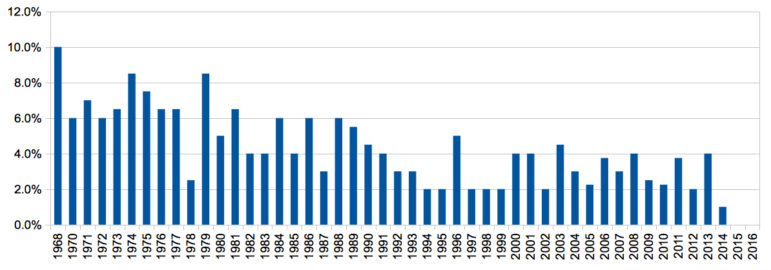
The hike in rent stabilized , one-year leases approved by the Rent Guidelines Board in votes from 1968 through last night. In years when different increases were approved for different classes of apartments, we report the lowest one.
Last night’s vote by the Rent Guidelines Board to continue, for a second year, a freeze on rents for one-year renewals of leases on rent-stabilized apartments would have been huge news under previous mayors, who tended to deliver at least modest increases even during severe recessions (of which there have been seven since the advent of the RGB). As the chart above illustrates, the previous low mark was set by Mayor de Blasio in his first year in office, when the board okayed a 1 percent increase.
The continued freeze was not welcomed by landlords. Patrick Siconolfi, executive director of Community Housing Improvement Program, said in a statement: “The freeze damages housing. With municipal taxes making up the largest percentage of a building’s operating costs, the city needs to look instead at lowering the high property tax rates levied upon multi-family building owners rather than unilaterally freezing rent for an additional year. This is merely a short term fix to a long term, systematic problem plaguing our city.”
The mayor’s allies hailed it. “New York City is in the midst of a housing crisis and as we work together with our partners in government to create new affordable housing units, we must also ensure existing rent stabilized homes are protected from unreasonable rent hikes,” read the reaction by Speaker Melissa Mark-Viverito. “This rent freeze, along with a two percent increase on two-year leases, will provide relief to over 1.1 million rent stabilized tenants in New York City and will help alleviate the burden of increased rent-,even as wages remain stagnant.”
Some advocates were disappointed that there wasn’t a rent rollback, and were upset by the hike on two-year leases. After all, despite improving wage and employment numbers and a reduction in evictions, the housing crunch is still very clearly reflected in the homeless shelter census. But as the Community Service Society (a City Limits funder) said in a statement before the final vote, a freeze does “significantly slow down rent pressures on low-income New Yorkers living in rent-stabilized apartments and preserve this critical source of affordable housing.”
Still, the momentum in that housing market that has proven hard to arrest. According to the RGB’s research, the number of units that left the stabilized system because of high-rent vacancy destabilization (which occurs when an apartment’s legal rent grows beyond a state-imposed threshold) increased 29 percent in 2014 and the same amount in 2015, despite the 1 percent and 0 percent RGB hikes during those years.

RGB









One thought on “Second Year of the de Blasio Rent Freeze: A Graphic History”
is this supposed to be a disincentive to sign new leases since the Rent Act of 2015 means that the new tenants will be stabilized and unlike the many older regulated tenants probably do not own houses in Flushing, Brooklyn, New Jersey, Blakelee Pennsylvania and Battery Park City like Don B. Lee who is running for Sheldon Silver’s old seat?